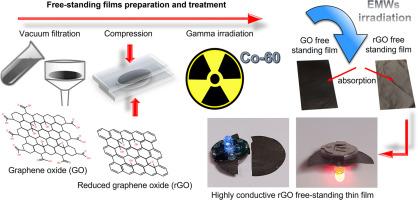Sustainable gamma irradiation strategy for GO and rGO modification: Impact on electromagnetic interference shielding efficiency
IF 7.1
Q1 ENGINEERING, CHEMICAL
引用次数: 0
Abstract
Electromagnetic interference (EMI) has emerged as a significant issue in contemporary electronic systems, particularly within aerospace, defense, and communication technology. Graphene-derived materials, including graphene oxide (GO) and reduced graphene oxide (rGO), present remarkable potential for lightweight, flexible, and EMI shielding solutions owing to their adjustable electrical conductivity and structural integrity. This study introduces an eco-friendly method for adjusting the EMI shielding effectiveness (EMI SE) of free-standing films made from GO and rGO by controlled gamma irradiation at low (50 kGy) and high (300 kGy) doses, conducted in two types of media: air and isopropyl alcohol (IPA). The structural alterations generated by irradiation were characterized by Raman and Infrared spectroscopies, X-ray diffraction (XRD), scanning electron microscopy (SEM), and contact angle measurements, indicating changes in defect density, surface roughness, and hydrophilicity. Results indicate that gamma irradiation can precisely adjust the oxidation/reduction equilibrium, hence boosting conductivity in rGO and improving interfacial polarization in GO. Remarkably, rGO films exposed to air demonstrated exceptional EMI SE values above 20 dB in the X-band (8–12 GHz), signifying their suitability for advanced shielding applications. This research illustrates the effectiveness of gamma irradiation as an environmentally friendly, scalable method for modifying the characteristics of graphene-based materials, facilitating their incorporation into advanced aeronautical and electronic equipment.

氧化石墨烯和还原氧化石墨烯改性的可持续伽马辐照策略:对电磁干扰屏蔽效率的影响
电磁干扰(EMI)已经成为当代电子系统中的一个重要问题,特别是在航空航天、国防和通信技术领域。石墨烯衍生材料,包括氧化石墨烯(GO)和还原氧化石墨烯(rGO),由于其可调节的导电性和结构完整性,在轻质、柔性和EMI屏蔽解决方案方面具有显着的潜力。本研究介绍了一种生态友好的方法,通过控制低(50 kGy)和高(300 kGy)剂量的伽马辐射,在空气和异丙醇(IPA)两种介质中进行,来调节氧化石墨烯和还原氧化石墨烯制成的独立薄膜的EMI屏蔽效能(EMI SE)。通过拉曼和红外光谱、x射线衍射(XRD)、扫描电镜(SEM)和接触角测量对辐照产生的结构变化进行了表征,表明缺陷密度、表面粗糙度和亲水性发生了变化。结果表明,伽马辐射可以精确调节氧化还原平衡,从而提高氧化石墨烯的电导率,改善氧化石墨烯的界面极化。值得注意的是,暴露在空气中的氧化石墨烯薄膜在x波段(8-12 GHz)显示出超过20 dB的特殊EMI SE值,这表明它们适用于高级屏蔽应用。这项研究表明,伽马辐射作为一种环保、可扩展的方法,可以有效地改变石墨烯基材料的特性,促进其融入先进的航空和电子设备。
本文章由计算机程序翻译,如有差异,请以英文原文为准。
求助全文
约1分钟内获得全文
求助全文
来源期刊

Chemical Engineering Journal Advances
Engineering-Industrial and Manufacturing Engineering
CiteScore
8.30
自引率
0.00%
发文量
213
审稿时长
26 days
 求助内容:
求助内容: 应助结果提醒方式:
应助结果提醒方式:


